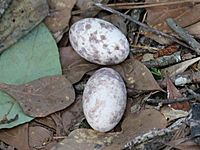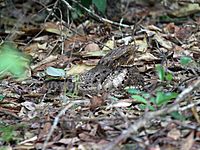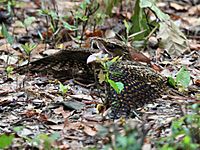Chuck-will's-widow facts for kids
Quick facts for kids Chuck-will's-widow |
|
|---|---|
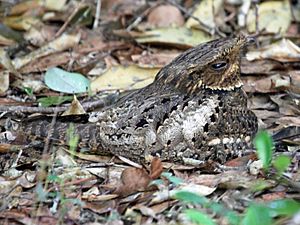 |
|
| Female | |
| Conservation status | |
| Scientific classification | |
| Genus: |
Antrostomus
|
| Species: |
carolinensis
|
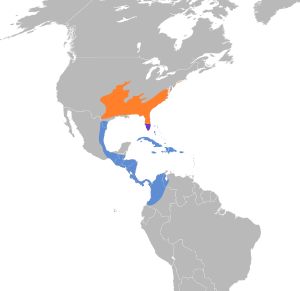 |
|
| Synonyms | |
|
Caprimulgus carolinensis |
|
The chuck-will's-widow (Antrostomus carolinensis) is a special bird that flies mostly at night. It belongs to the nightjar family. You can find it in the southeastern United States. It likes places near swamps, rocky hills, and pine forests. When winter comes, this bird travels a long way. It migrates to the West Indies, Central America, and northwestern South America.
Contents
Understanding the Chuck-will's-widow
This bird is often mixed up with another bird called the whippoorwill. This happens because their calls sound similar. Also, both birds have unusual names. Even though they are related, they are two different species of birds.
What the Chuck-will's-widow Looks Like
The chuck-will's-widow has a short beak and a long tail. These are common features for birds in the nightjar family. Its feathers are brownish with spots. It has a light brown throat. Its reddish-brown feathers have black lines. The head and chest have brown and white patterns.
Male chuck-will's-widows have white patches on their outer tail feathers. This bird is the biggest nightjar in North America. It can be about 28 to 33 cm (11 to 13 in) long. Its wings can spread from 58 to 66 cm (23 to 26 in) wide. The bird's weight is usually between 66 to 188 g (2.3 to 6.6 oz).
The Bird's Unique Call
The chuck-will's-widow gets its name from its song. You can often hear this song at night. It sounds like "chuck-will's-widow" repeated over and over. The song has a vibrating sound in the middle. It is slower and lower than the whip-poor-will's song. Some people also call this bird "Chuckwuts-widow" or "Chip-fell-out-of-a-oak."
What the Chuck-will's-widow Eats
This bird mainly eats insects. It especially likes insects that are active at night. These include moths, beetles, and flying ants. Sometimes, it will also eat small birds and bats. It swallows its food whole.
How the Chuck-will's-widow Breeds
Female chuck-will's-widows lay their eggs on the ground. They choose spots with dead leaves. The eggs are pink with brown and lavender spots. The female bird then sits on the eggs to keep them warm. This process is called incubating.
Gallery
Images for kids
See also
 In Spanish: Chotacabras de paso para niños
In Spanish: Chotacabras de paso para niños



